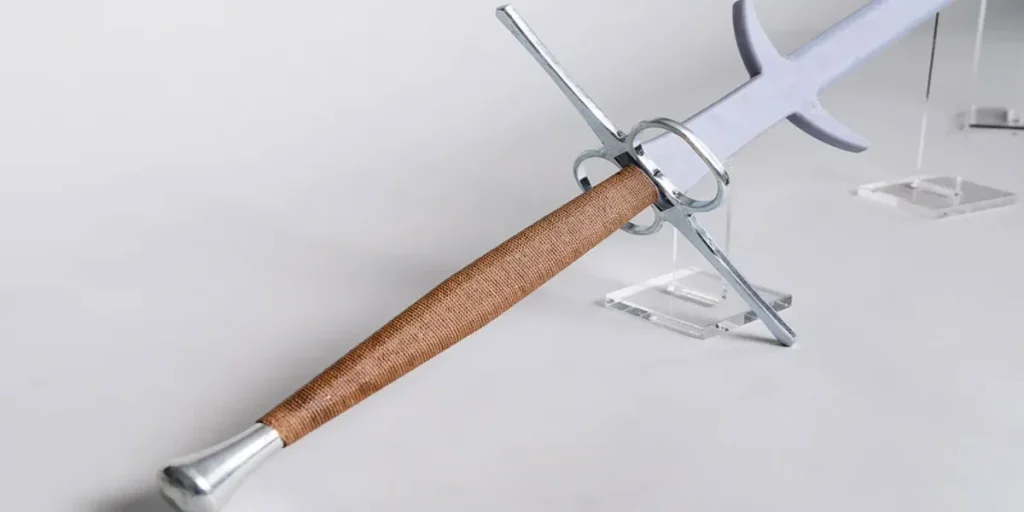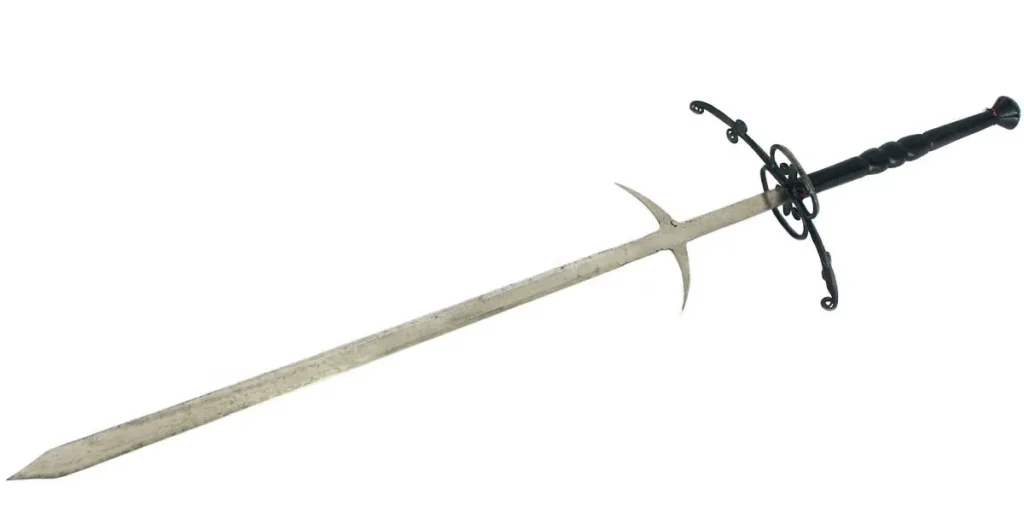A typical Zweihander sword weighs between 3 to 3.5 kg (6.6 to 7.7 pounds). Historical examples usually come within this weight range.
The Zweihander, German for “two-hander,” stands as a symbol of might and skill from the Renaissance era.
These massive swords, crafted for use with both hands, were a feared sight on the battlefield.
Commonly associated with Germanic landsknechts, mercenaries known for their audacious fighting style, the Zweihander’s impressive length and weight required considerable strength and dexterity to wield effectively.
Renowned for its ability to break pike formations, the Zweihander also played a ceremonial role, often being used in processions and parades.
Today, history enthusiasts and collectors seek out these great swords, not just as relics of war, but as masterpieces of form and function that tell the tale of a bygone era of close-combat warfare.
Zweihander’s Historical Significance
The Zweihander, a colossal sword from bygone eras, is renowned for its grandeur and might.
This impressive weapon not only dominated medieval battlefields but also became a symbol of skill and bravery.
Let’s delve into its storied past and uncover the weight it carried—not only in steel but also in history.
Origins And Evolution
Emerging in the late Middle Ages, the Zweihander became a powerful icon. Its name, meaning “two-hander” in German, references the unique grip needed to wield it.
Remarkably, blacksmiths forged these swords to impressive lengths, often exceeding 60 inches.
- Finesse and strength characterized its wielders.
- Renowned for breaking enemy ranks and defending against pikes.
- Swords evolved from earlier longswords with increased size.
Famed Battles And Warriors
Legends clad in steel wielded the Zweihander on many historic battlefields. Its presence was a game-changer, often turning the tides of war.
Such warriors held titles like German Landsknechte, elite mercenaries known for their prowess.
- The Battle of Gravelotte (1568) saw wide use of this mighty blade.
- Legendary wielders like Pier Gerlofs Donia boasted extraordinary strength.
Duelists and heroes brandished the Zweihander with honor and distinction, etching their names into the annals of time.
Anatomy Of The Zweihander

The Zweihander is a massive sword from history, known for its power and size. Many knights and warriors held it to show strength and skill.
Let’s explore each part of this legendary weapon to understand why it weighs so much and how it became a symbol of might on the battlefields of old.
Blade Characteristics
The blade defines the Zweihander. Its length can reach a striking 6 feet. This allows long reach in combat. Forged from steel, the blade features various designs:
- Flat and wide, to give powerful slices
- Sharp-edged, for deep cuts
- Pointed tip, effective for thrusting
The blade’s weight contributes notably to the total weight of the Zweihander, often around 3 to 3.5 kilograms (6.6 to 7.7 pounds).
Hilt And Guard Complexities
The hilt of the Zweihander includes the grip, pommel, and guard, carefully tailored for balance and control:
| Part | Material | Purpose |
|---|---|---|
| Grip | Leather or wood | Ensures a firm hold |
| Pommel | Steel or iron | Counterbalances the blade |
| Guard | Metal | Protects the hand |
The hilt is not just for handling but also adds weight, balancing the heft of the blade, ensuring the Zweihander’s total weight stays manageable for its wielder.
The Weight Of War: The Zweihander’s Heft
The zweihander, a symbol of might in medieval warfare, stands out for its impressive size. Soldiers wielded this massive sword with both hands to deliver devastating blows.
Yet, its real power lay in its significant weight, which we will dive into, unraveling the balance between heft and combat effectiveness.
Average Weights Unveiled
Understanding the zweihander begins with its weight, fundamental to its role on the battlefield.
Common zweihanders tip the scales significantly, showcasing a range of impressive heft:
- Lighter Zweihanders: Around 1.2 kg (2.6 lbs)
- Average Zweihanders: About 2 to 3.2 kg (4.4 to 7 lbs)
- Heavier Models: Up to 3.5 kg (7.7 lbs) or more
These weights indicate the zweihander’s considerable presence in the hands of a skilled warrior.
Weight Vs. Maneuverability
Balancing weight with maneuverability is critical for any weapon, especially for something as substantial as the zweihander.
Each swing required precision, timing, and strength due to its weight. With a heavy zweihander:
| Weight | Benefits | Challenges |
|---|---|---|
| Heavier | Greater impact in strikes, ability to break enemy lines | Reduced speed and agility, increased fatigue |
| Lighter | Faster swings, enhanced control for skilled hands | Less force behind blows, may struggle against armor |
In conclusion, striking a balance between the zweihander’s weight and wieldability was essential for medieval fighters.
The sword’s design reflects a calculated trade-off, ensuring power while still permitting the agility required in combat scenarios.
Forging The Giant: Traditional Techniques

The colossal Zweihander is a symbol of might from medieval times. Its creation is an art, drawing on years of blacksmithing tradition.
Craftsmen wielded hammers and tongs, shaping the metal into its fearsome form. Let’s delve into the ancient craft of forging these massive swords, step by step.
Materials And Smithing
Key to every Zweihander is its blend of strength and flexibility. Quality iron ore and additives fuse in a fiery furnace.
- Iron ore: The core component
- Charcoal: Fuels the forge
- Flux: Cleans the metal
| Material | Purpose |
|---|---|
| Iron ore | For the blade |
| Charcoal | To heat the forge |
| Flux | To cleanse impurities |
Through heating and hammering, the swordsmith transforms these materials. The forge bellows life into the fire, setting the stage for the smith’s dance of creation.
Swordsmith’s Challenges
The Zweihander’s sheer size brings unique obstacles. Even heat distribution and constant attention are vital.
- Attaining the right temperature
- Handling the sword evenly
- Achieving perfect balance
Striking the metal, the swordsmith’s hammer sings. With each beat, the blade’s soul takes shape. Crafting a Zweihander is a test of skill. The smith must maintain a sharp focus on every aspect:
- Weight
- Managing the heft without sacrificing quality
- Balance
- Ensuring the sword feels right in the wielder’s hands
- Edge
- Creating a keen blade to withstand fierce blows
An expert smith overcomes these hurdles, forging a weapon of legend.
Contemporary Zweihanders
Welcome to the armory of history where contemporary Zweihanders stand tall, capturing the awe of enthusiasts.
These large swords, once wielded by mighty warriors on European battlefields, now enchant modern collectors and swordsmanship aficionados alike.
Let’s delve into the world of these imposing blades in today’s context.
Modern Reproductions
Craftsmen today forge Zweihanders with an eye for historical accuracy and an unyielding respect for tradition.
These modern reproductions aren’t merely decorative; they’re functional and battle-ready.
- Materials: High-carbon steel mirrors the resilience of ancient forges.
- Weight: Typically, they are lighter than their historic counterparts, around 3 to 3.5 kg (6.6 to 7.7 lbs).
- Balance: A focus on balance makes them suitable for martial arts.
Collector’s Insights And Uses
Modern-day collectors prize Zweihanders for their grandeur and craftsmanship. Beyond their visual appeal, these swords find their uses in a handful of unique ways.
- Historical Reenactment: Participants value accuracy for immersive experiences.
- Swordsmanship: Practitioners appreciate the weight and balance for training.
- Display: They become centerpieces of collections, evoking medieval might.
FAQs About the Weight of a Zweihander
What Is The Average Weight Of A Zweihander?
The average Zweihander weighs about 2 to 3. 2 kilograms (4. 4 to 7 pounds).
This weight allows for both forceful swings and manageability in battle.
How Does A Zweihander’s Weight Impact Its Use?
A Zweihander’s weight affects its maneuverability and usage. Heavier swords deliver powerful strikes but require more strength and skill to wield effectively.
Are Zweihanders Still Used Today?
Zweihanders are not used in modern combat but are popular amongst collectors, historical re-enactors, and martial artists studying traditional European swordsmanship.
What Period Were Zweihanders Most Popular?
Zweihanders were most popular during the Renaissance, roughly between the 15th and 17th centuries.
They symbolized the might of mercenaries and were used in battlefield confrontations.
Conclusion
Understanding the weight of a Zweihander is crucial for historians and enthusiasts alike. Typically, these giant swords tip the scales at around 2-3. 2 kg.
This insight reflects the blend of heft and agility favored by warriors of the past.
As we close this discussion, remember that the Zweihander remains a symbol of medieval prowess, its weight a testament to the strength and skill of the swordsmen who wielded it.
